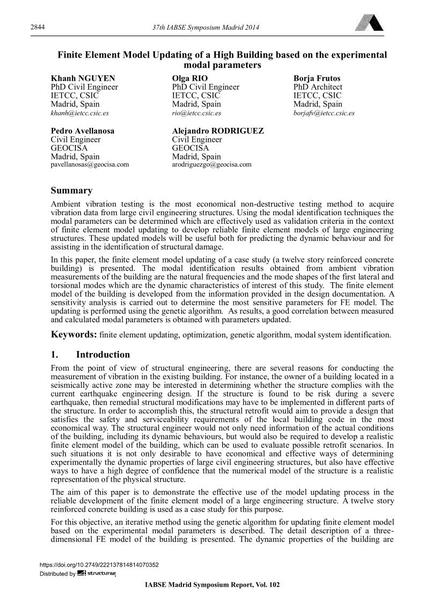Finite Element Model Updating of a High Building based on the experimental modal parameters

|
|
|||||||||||
Détails bibliographiques
| Auteur(s): |
Khanh Nguyen
Olga Río Borja Frutos Pedro Avellanosa Alejandro Rodriguez |
||||
|---|---|---|---|---|---|
| Médium: | papier de conférence | ||||
| Langue(s): | anglais | ||||
| Conférence: | IABSE Symposium: Engineering for Progress, Nature and People, Madrid, Spain, 3-5 September 2014 | ||||
| Publié dans: | IABSE Symposium Madrid 2014 | ||||
|
|||||
| Page(s): | 2844-2851 | ||||
| Nombre total de pages (du PDF): | 8 | ||||
| Année: | 2014 | ||||
| DOI: | 10.2749/222137814814070352 | ||||
| Abstrait: |
Ambient vibration testing is the most economical non-destructive testing method to acquire vibration data from large civil engineering structures. Using the modal identification techniques the modal parameters can be determined which are effectively used as validation criteria in the context of finite element model updating to develop reliable finite element models of large engineering structures. These updated models will be useful both for predicting the dynamic behaviour and for assisting in the identification of structural damage. In this paper, the finite element model updating of a case study (a twelve story reinforced concrete building) is presented. The modal identification results obtained from ambient vibration measurements of the building are the natural frequencies and the mode shapes of the first lateral and torsional modes which are the dynamic characteristics of interest of this study. The finite element model of the building is developed from the information provided in the design documentation. A sensitivity analysis is carried out to determine the most sensitive parameters for FE model. The updating is performed using the genetic algorithm. As results, a good correlation between measured and calculated modal parameters is obtained with parameters updated. |
||||
